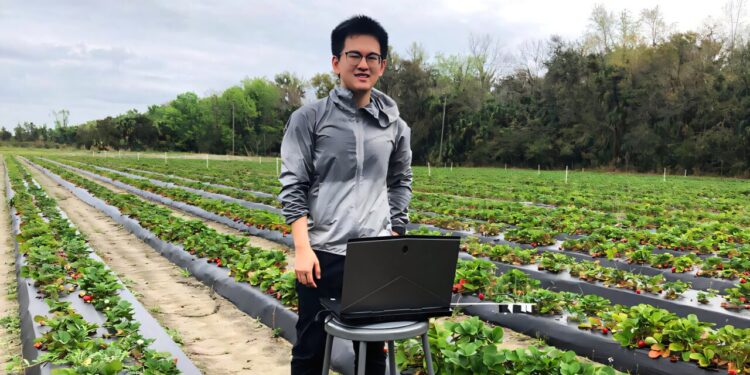Washington State University researchers have developed an AI-guided robot that uses puffs of air to expose hidden strawberries before harvesting them, addressing a persistent challenge in agricultural automation.
The robot combines soft silicone grippers with a fan system that blows leaves aside, allowing it to detect and harvest berries typically concealed under plant canopies. During field trials in Huizhou, China, the machine successfully picked nearly three out of four ripe strawberries using its air system, representing a 16 percent improvement over trials without the fan.
Each berry required approximately 20 seconds for the robot to identify and harvest. The team, which includes Chinese scientists, published their results in the journal Computers and Electronics in Agriculture.
“Right now, [the technology] won’t totally replace manual labour,” said lead author Zixuan He, now a postdoctoral researcher at Aarhus University in Denmark. “But it could be a very promising supplement when you don’t have enough people in the field.”
Strawberry farming faces increasing labour shortages and rising costs, driving interest in automation solutions. Previous robotic harvesting systems were primarily tested in controlled greenhouse environments or on table-top plants where fruit hangs below canopies and remains easily accessible. However, strawberries grown in typical US field conditions present greater challenges due to hidden fruit beneath leaf cover.
The WSU robot integrates several technological innovations: an AI-powered vision system trained with deep learning models to identify ripe berries and determine optimal harvesting approaches; soft grippers designed to handle fruit delicately; and an air delivery system that parts leaves without damaging plants.
The research represents the first demonstration of field-scale robotic strawberry harvesting using airflow rather than mechanical leaf manipulation. This approach demonstrates how AI algorithms can enhance robot effectiveness in complex, unpredictable agricultural environments.
While slower than human pickers, researchers estimate that deploying 10 robots with four arms each could harvest approximately 300,000 strawberries in 43 hours. The scientists suggest similar approaches could apply to other crops, including grapes.
The project reflects broader agricultural technology innovation emerging from the Pacific Northwest. A British Columbia startup developing mushroom-picking robots recently raised $40 million, whilst Seattle-area companies Carbon Robotics and Aigen produce field robots that use lasers or blades to eliminate weeds. Idaho’s TerraClear has developed machines for clearing rocks from farmland.
However, significant challenges remain before such technology achieves commercial viability. The 20-second harvesting time per berry suggests substantial efficiency improvements are needed to compete with human labour. Additionally, the robot’s 75 percent success rate, whilst promising, leaves room for improvement in fruit detection and gentle handling.
The economic viability of robotic harvesting depends on factors including equipment costs, maintenance requirements, and seasonal labour availability. For many farms, robots may serve as labour supplements during peak harvest periods rather than complete replacements for human workers.
The WSU research contributes to ongoing efforts to address agricultural labour challenges through automation, though practical implementation will require continued technological refinement and cost reduction to achieve widespread adoption in commercial farming operations.







